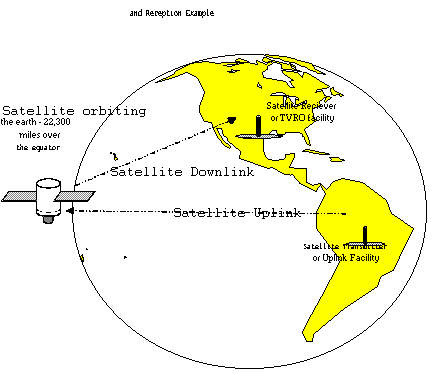The ability to transmit and receive television pictures instantaneously over vast distances is the space-age legacy provided to us in the form of broadcast satellite technology. Before satellite television transmission was available, major news events had to be videotaped by television networks, mailed to network affiliate television stations, and later broadcast to viewers at a future date and time - possibly days or even weeks after the event had taken place. Thanks to satellites we can watch news and sports events "live" on TV, view some foreign television programming, check out the latest movie releases on HBO, Showtime, and other "movie" networks, or see major network programming as it is broadcast from various locales all over North and South America.
Satellite television works in this way: Satellites in geosynchronous earth orbit 23,000 miles out in space re-transmit "uplinked" television signals back to earth. The satellites are "parked" in geosynchronous orbit so they remain in the same point in the sky at all times, making it easy to point an antenna at a specific satellite, and therefore receive television programming. Most satellite television transmissions are one-way, so most satellite reception sites are called "TVRO" sites. TVRO stands for "Television Receive Only" which means a TVRO facility has no capability for television uplinking or similar two-way communication via satellite - it is receive only.
Television signals must be sent to the satellite before they can be re-broadcast back to earth. This transmission part of satellite television is called the "uplink". When the satellite receives a television signal from a television station uplink the satellite then immediately returns that signal down to earth again in the form of a "downlink". Satellite television receivers can "tune in" to the downlinked signals and convert them into a usable televisionpicture. The graphic on the next page illustrates the uplink and downlink process:

Using the previous graphic as an example -satellite broadcast and reception occurs in this way:
1. A television program is either videotaped or performed live in front of a television camera.
2. The television signal is sent from the videotape recorder or video camera to a satellite television transmitter located atan "uplink" site - possibly a television station.
3. The satellite television transmitter sends the television broadcast to the satellite by way of a large satellite antenna (satellite dish).
4. The satellite receives the program, then re-amplifies the program and transmits it back to earth.
5. A satellite receive site, equipped with an antenna (dish) pointed at the satellite, receives the television program - which is viewed immediately or recorded onto videotape.